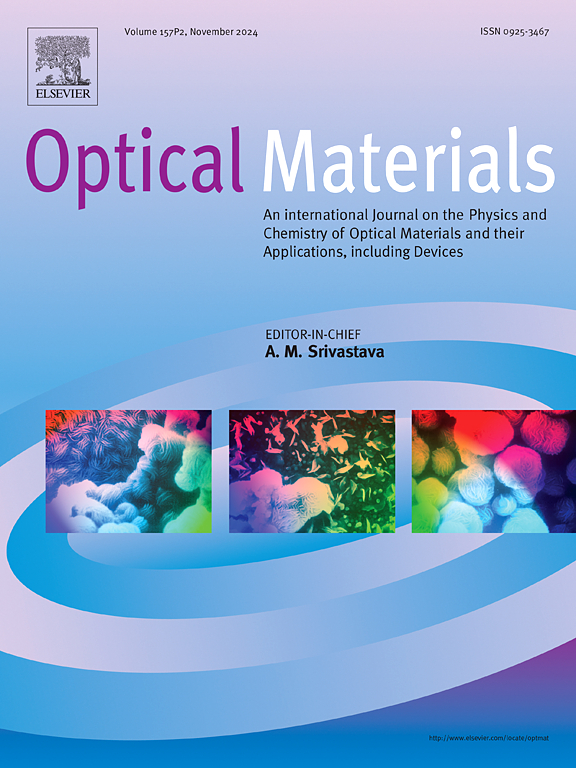通过Al2O3掺杂优化B2O3-Bi2O3-K2O玻璃:结构、热、光吸收、弹性模量和γ射线衰减行为
IF 3.8
3区 材料科学
Q2 MATERIALS SCIENCE, MULTIDISCIPLINARY
引用次数: 0
摘要
利用热熔和快速冷却技术合成了化学式为(65-x)B2O3-15Bi2O3-20K2O-xAl2O3(0.0 ≤ x ≤ 1.2 mol%)的AKB玻璃,系统地研究了Al2O3在增强结构、热、光吸收、弹性模量和γ射线衰减行为方面的作用。通过 XRD 分析确定了玻璃的非晶体结构。傅立叶变换红外光谱显示,Al2O3 的加入量达到 0.6 摩尔%时,会促进 BO3 单元向 BO4 单元的转化,从而促进额外非桥接氧位点的发展。然而,超过 0.6 摩尔%的 Al2O3 后,[AlO4]- 单元的形成与高度扭曲的[AlO6]3- 单元相比变得更加主要。这些 [AlO4]- 单元与非桥接氧原子相互作用,促进了电荷的稳定,并增强了玻璃网络内部的交联。密度的上升伴随着摩尔体积的下降,这表明随着 Al2O3 浓度的增加,玻璃网络会被压实。在 Al2O3 浓度达到 0.6 摩尔%时,光带隙呈下降趋势,表明结构紊乱程度增加。然而,当 Al2O3 浓度超过 0.6 摩尔%时,光带隙增加,表明玻璃结构向更有序、更交联的方向转变。DSC 分析进一步证实了热稳定性的增强,当 Al2O3 浓度为 0.3 摩尔% 时,最高玻璃化转变温度为 337.556 °C。Makishima-Mackenzie 模型表明,随着 Al2O3 的掺入,机械性能得到改善,这主要是由于平均键能密度的增加。这种增强可强化玻璃网络,从而提高刚度、机械稳定性和整体结构完整性。γ射线衰减分析表明,与广泛使用的商业屏蔽材料(包括 RS-253-G1 和 RS-360)相比,AKB 玻璃样品具有更高的衰减效率。虽然 AKB 玻璃的半值层大于 1.389 厘米,超过了 RS-520,但与混凝土和其他商用玻璃替代品相比,它们仍然表现出更优越的屏蔽能力。在 AKB 玻璃样品中,AKB0.3(0.3 摩尔% Al2O3)成分具有出色的热稳定性,其较高的玻璃化转变温度表明了这一点。这一特性使其非常适合用于 0.662 MeV 的辐射屏蔽,因为热稳定性对确保最佳性能至关重要。本文章由计算机程序翻译,如有差异,请以英文原文为准。
Optimizing B2O3–Bi2O3–K2O glass via Al2O3 doping: Structural, thermal, optical absorption, elastic moduli, and γ-ray attenuation behavior
Utilizing the thermal fusion and rapid cooling technique, AKB glasses with the chemical formula (65-x)B2O3–15Bi2O3–20K2O-xAl2O3 (0.0 ≤ x ≤ 1.2 mol%) were synthesized to systematically examine the role of Al2O3 in enhancing the structural, thermal, optical absorption, elastic moduli, and γ-ray attenuation behavior. The non-crystalline structure of the glasses was affirmed via XRD analysis. FTIR spectroscopy revealed that the incorporation of Al2O3 up to 0.6 mol% promotes the transformation of BO3 units into BO4 units, facilitating the development of additional non-bridging oxygen sites. However, beyond 0.6 mol% Al2O3, the formation of [AlO4]- units becomes more dominant compared to the highly distorted [AlO6]3- units. These [AlO4]- units interact with non-bridging oxygen atoms, facilitating charge stabilization and enhancing cross-linking within the glass network. A rise in density accompanied by a decline in molar volume, suggests a compaction of the glass network with increasing Al2O3 concentration. The optical band gap exhibited a decreasing trend up to 0.6 mol% Al2O3, indicating an increase in structural disorder. Nevertheless, for Al2O3 concentrations exceeding 0.6 mol%, the optical band gap increased, suggesting a transition toward a more ordered and cross-linked glass structure. DSC analysis further confirmed enhanced thermal stability, with the highest glass transition temperature of 337.556 °C occurring at 0.3 mol% Al2O3. The Makishima-Mackenzie model demonstrated an improvement in mechanical properties with Al2O3 doping, primarily due to the increase in mean bonding energy density. This enhancement strengthens the glass network, resulting in greater rigidity, superior mechanical stability, and improved overall structural integrity. γ-ray attenuation analysis revealed that the AKB glass samples exhibit superior attenuation efficiency compared to widely used commercial shielding materials, including RS-253-G1 and RS-360. While AKB glasses possess a half-value layer greater than 1.389 cm, exceeding that of RS-520, they still demonstrate superior shielding capabilities relative to concrete and other commercial glass alternatives. Among the AKB glass samples, the AKB0.3 (0.3 mol% Al2O3) composition exhibited outstanding thermal stability, as indicated by its higher glass transition temperature. This property makes it highly suitable for radiation shielding at 0.662 MeV, where thermal stability is essential for ensuring optimal performance.
求助全文
通过发布文献求助,成功后即可免费获取论文全文。
去求助
来源期刊

Optical Materials
工程技术-材料科学:综合
CiteScore
6.60
自引率
12.80%
发文量
1265
审稿时长
38 days
期刊介绍:
Optical Materials has an open access mirror journal Optical Materials: X, sharing the same aims and scope, editorial team, submission system and rigorous peer review.
The purpose of Optical Materials is to provide a means of communication and technology transfer between researchers who are interested in materials for potential device applications. The journal publishes original papers and review articles on the design, synthesis, characterisation and applications of optical materials.
OPTICAL MATERIALS focuses on:
• Optical Properties of Material Systems;
• The Materials Aspects of Optical Phenomena;
• The Materials Aspects of Devices and Applications.
Authors can submit separate research elements describing their data to Data in Brief and methods to Methods X.
 求助内容:
求助内容: 应助结果提醒方式:
应助结果提醒方式:


